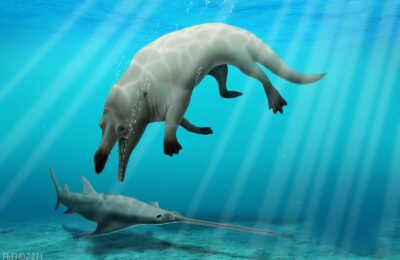Boessenecker et al., Convergent Evolution of Swimming Adaptations in Modern Whales Revealed by a Large Macrophagous Dolphin from the Oligocene of South Carolina, Current Biology (2020), https://doi.org/10.1016/j.cub.2020.06.012
Ancient whales
Thirty million years ago, giant carnivorous dolphins roamed the seas of South Carolina. These ancient sea-dwelling animals sped through the water, ate large prey, and acted a lot like modern killer whales do, although ancient dolphins looked pretty different. Today, the skeletons of ancient dolphins like these are providing insight into how whales and dolphins transitioned from land to sea, giving rise to their modern counterparts.
In a recent paper in the journal Current Biology, scientists describe the skeleton of a giant dolphin from the Oligocene period (roughly 23-34 million years ago) in South Carolina. This fossil is an ancient odontocete, or toothed whale.
By looking at just the skeletal remains of one of these ancient odontocetes, and by comparing it to other fossils and modern whales, we can learn a lot about how it moved, what it might have eaten, and the ecological role it filled. From an even broader standpoint, we can understand the incredible evolutionary journey that modern whales took to adapt to a fully aquatic lifestyle.
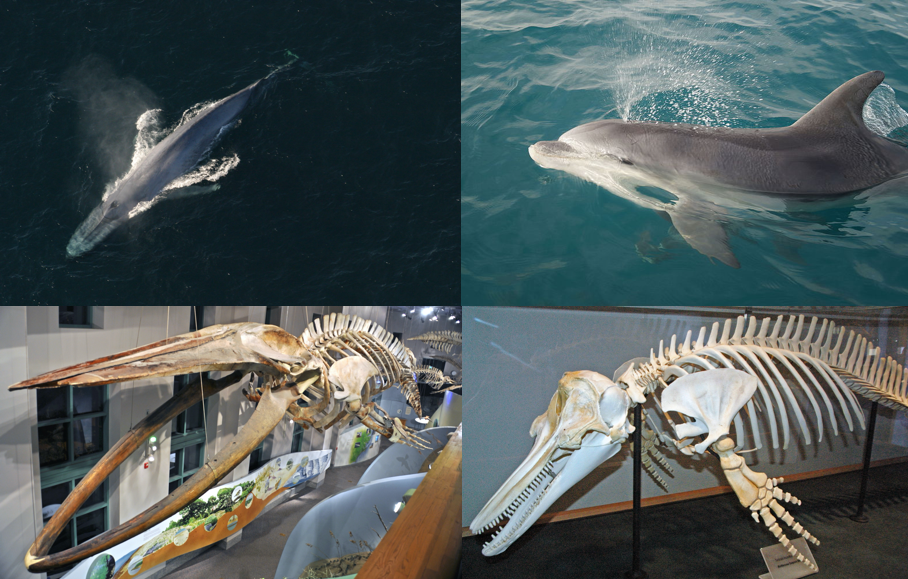
Fossil teeth provide clues from the past
Ankylorhiza tiedemani, the dolphin species described in the article, is named for its teeth (“ankylorhiza” is Greek for “fused roots”). Teeth are often vital for paleontologists looking at the similarities and differences between extinct and modern species. Teeth are valuable for species identification, and they can give us information about what an extinct animal ate when it was alive.
The teeth found with the skeleton of A. tiedemani are relatively simple compared to those of other ancient whales. These teeth sat in a short but strong snout, likely used to catch and puncture large prey. Some of the fossilized teeth were broken, indicating wear from impacts on bones or other hard prey items. Ankylorhiza teeth also feature a pair of tusks, which may have been used by males in combat or to ram into prey and catch their food.
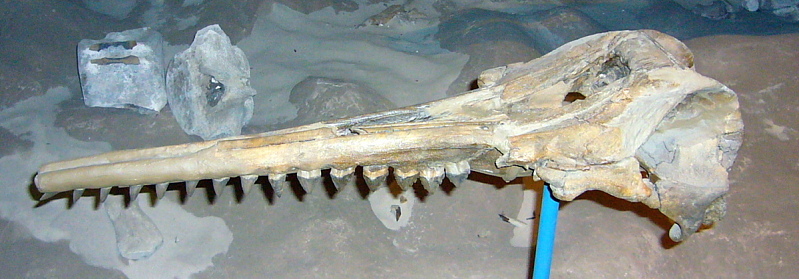
The size of this ancient dolphin also indicates that Ankylorhiza was a predator which consumed relatively large animals. Estimated to be about 4.8 meters (roughly 15.7 feet) in length, this large odontocete was big enough for macrophagy, or the consumption of large prey items, and was likely the first large, macrophagous odontocete. Today, that role is filled by killer whales.
A journey from land to sea
A large ocean-dwelling creature needs to be able to move efficiently through the water, especially if it needs to hunt large fish or other marine mammals. Studying locomotion in whales and dolphins shows the rapid changes the ancestors of these animals underwent in their colonization of the ocean. Over time, hooved creatures transitioned to semi-aquatic mammals paddling in shallow seas, before finally being overtaken by fully aquatic ancient and modern whales. Ancient and modern whales are united by, among other traits, a fusiform shape (rounder in the middle and tapered at the ends), front flippers, and flukes at the end of their tails.
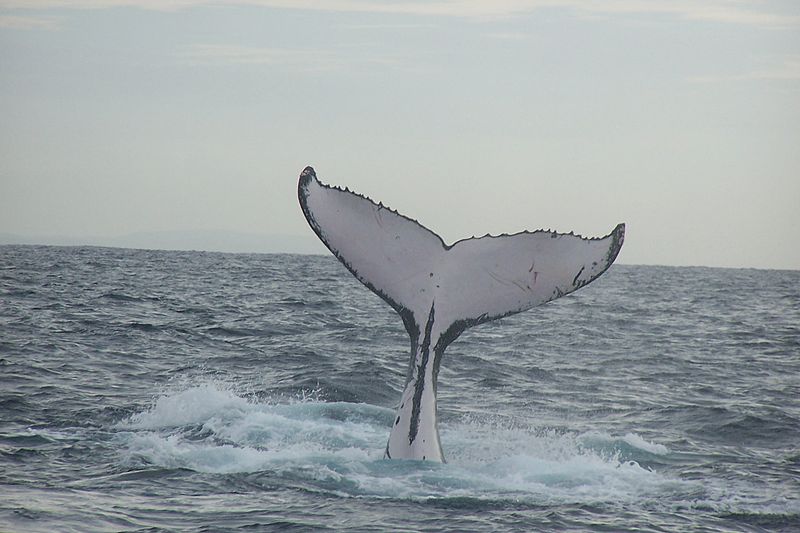
Whales and dolphins swim by undulating their spines and tails up and down, using their flukes and flippers to propel them forwards. This required gradual changes in the morphology of their vertebrae and the bones of their forelimbs, which look a lot like shortened versions of human arms with elongated fingers. Some of these modifications on the innovations of the earliest fully aquatic whales include the narrowing of vertebral bones just before the fluke, an area known as the peduncle. However, A. tiedemani did not have bones as narrow as those in modern whales, making it a clear intermediate between known older and younger toothed whale species. A. tiedemani is a stepping stone species in this evolution of physical traits necessary for efficient underwater swimming.
The skeleton of A. tiedemani also reveals two distinct evolutionary paths to arriving at traits common to all modern whales. As whales evolved, they split into two major groups: toothed whales (like dolphins, orcas, and sperm whales) and baleen whales (like humpbacks and blue whales). The presence of a thicker peduncle and altered forelimbs in A. tiedemani reveals that some changes in peduncles and forelimbs occurred after the split, rather than evolving in a common ancestor. The same is true for aspects of the forelimb, the bones of which shortened and changed as muscles were lost, the elbow became immobile, and these arms became powerful aquatic flippers which became better and better adapted for life underwater. Though these traits belong to both modern toothed whales and modern baleen whales, the two groups evolved them independently. In evolutionary biology, this independent evolution of the same or similar traits is known as convergent evolution, because distinct organisms converge on the same solution from different paths.
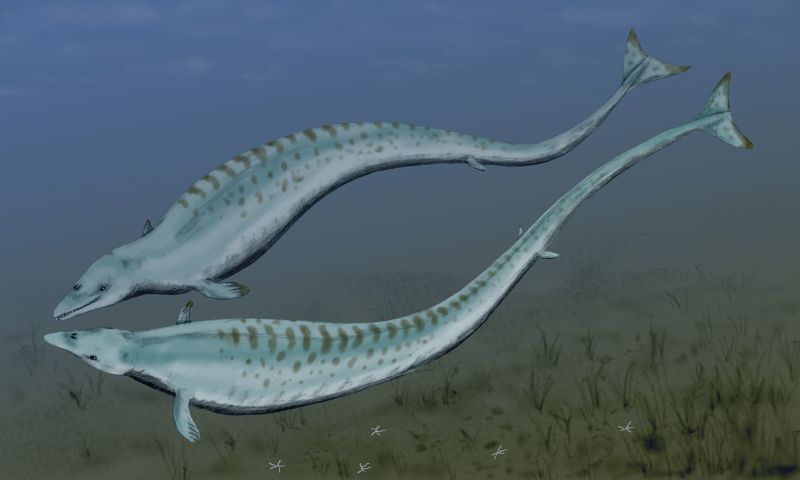
The discovery that baleen whales and toothed whales likely evolved aspects of their vertebrae, flukes, and flippers independently teaches us about evolutionary processes, and remarkable transitions, like whales moving from land to sea. After millions of years buried beneath the sediment, fossils like these emerge and give us a glimpse of evolutionary processes and astonishing transformations. The skeletal remains of a single individual that lived long ago have the power to shed light on the past, informing what we know of the present. Ankylorhiza tiedemani, a species that once lived and hunted in South Carolina’s seas, the first of a long line of large toothed whales, can provide a key to understanding how the animals we see today came to be.
I am a PhD candidate at Syracuse University studying marine mammal communication. My research focuses on analyzing underwater recordings of whale calls in order to better understand whale behavior. I’m also interested in education, outreach, and science communication. When I’m not listening to whale sounds, you can find me curled up with a good book or complaining about how much it snows in Syracuse.

